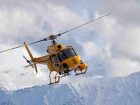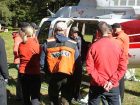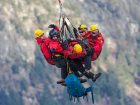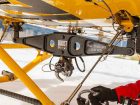
News
B.C.’s SAR Solution Providers
July 14, 2016 By Paul Dixon
Ground Search and Rescue (SAR) in British Columbia is unfortunately a growth industry. Over the past 30 years, through events such as EXPO 86 and the 2010 Winter Olympics, the world was exposed to all that B.C. has to offer across its richly diverse geography. Across the province, in a wide range of activities from extreme backcountry winter sports to enjoying a summer afternoon in an urban park, the number of people meeting with misadventure has been steadily rising.
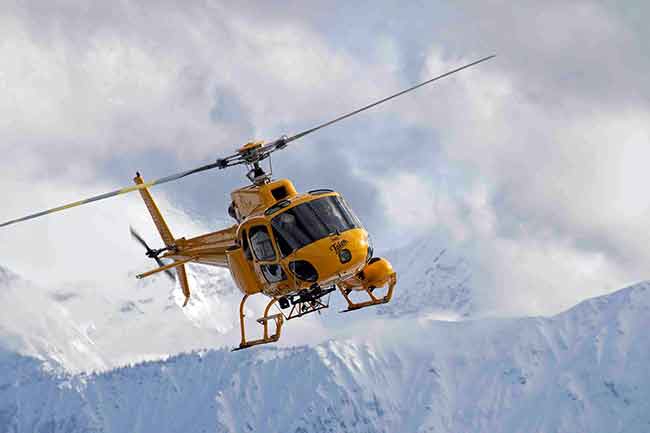 Talon Helicopters AStar B2 with Boost system installed. Ground Search and Rescue (SAR) in British Columbia is unfortunately a growth industry.
Talon Helicopters AStar B2 with Boost system installed. Ground Search and Rescue (SAR) in British Columbia is unfortunately a growth industry.In 1991, the province of B.C. recorded 400 “rescues” for the province. For 2015, that number exceeded 1,500. And as in much of life, the numbers don’t tell the whole story. Ground SAR in B.C. is done solely by volunteers – volunteers who have willingly agreed to place themselves on call 24/7/365, willing to respond as required, which last year accounted for more than 100,000 hours on task. The province estimates this would represent, at a minimum, at least $20 million dollars in direct salary that is their donated time, and another $50 million in capital costs and infrastructure that is raised by the individual teams within their respective communities.
Civilian SAR teams provide the expertise or “subject matter experts” to the lead agencies – which are the police in matters of missing persons or overdue travellers or the ambulance service when dealing with injured persons. As well, teams may be called on to provide assistance to the provincial coroner’s service, military SAR, or Parks Canada.
Teams will specialize in techniques specific to the challenges presented by the geography in their region, which can include rope rescue, swift water rescue, marine rescue, ice rescue, avalanche operations, SAR dogs, mountain rescue and cave rescue to name but a few. Increasingly, the use of helicopters is being integrated into rescue operations and a small number of teams are becoming increasingly proficient in helicopter long-line or HETS operations. As the call volume has grown, the increased use of helicopters has become a force multiplier in increasing the effectiveness of ground SAR, as well as decreasing the times in extracting injured persons from remote locations and delivering them to medical attention.
The B.C. SAR history
While the early use of helicopters in SAR duties was limited to the military, the most likely first use of a helicopter for rescue purposes in B.C. was a civilian operation. As related in the book Helicopters – The British Columbia Story, in October 1947 an employee of the Greater Vancouver Water Board suffered a severe fracture while working in the headwaters of the Capilano River. It took five hours for a doctor to hike into the scene and his assessment of the injuries called for immediate evacuation.
An attempt at landing a Tiger Moth close by failed, as the site was surrounded on three sides by sheer cliffs rising more than 500 metres. Aero Surveys was operating a Bell 47-B3 in the area and arrangements were made to use the helicopter. The trip from the remote site to a hastily improvised landing zone in a park close to the hospital took all of 15 minutes, sparing the injured man hours of agony and further medical complications. It’s a scenario that has become almost commonplace today.
Through the 1950s and 1960s, RCAF helicopters performed inland rescue missions on an ad hoc basis. Civilian SAR was beginning to coalesce and develop as a separate discipline as it evolved out of previously existing civil defence programs. The use of long-line (HETS) techniques was pioneered by Parks Canada back in the 1960s. By the 1990s, the use of HETS was being adopted by a small number of civilian teams in B.C.
George Zilahi, a long-time member of North Shore Rescue and now general manager of Emergco, a leading supplier of HETS equipment, recalls his first exposure to the use of helicopters in ground SAR almost 40 years ago. A ground team from NSR was searching for two young girls missing in the backcountry. A Bell 47 operated by a Vancouver radio station joined the search, located the girls and was able to land and extract them, no worse for wear. The problem was to find the ground team and notify them that the girls had been located, to spare them having to stay in the backcountry overnight. A phone call was made to a local logging company that made their company helicopter available. The pilot was able to locate the ground searchers, pass word that the search was called off and they were able to get themselves back to the staging area as night was descending.
The idea of saving a night out in the mountains seems simple, but it has a huge multiplying effect. As with a military operation, when a unit is deployed in the field, there is a requirement for support and logistics that often takes a much larger group. When the search team or teams are forced to stay out overnight, then the support group is stood up as well. It’s something that Michael Coyle, search manager with Coquitlam SAR points out that people often don’t consider.
“Teams have to be able to plan for multiple duty cycles,” he says. “It’s one thing to put a team out for the initial 10 to 12 hours, but you have to be able to replace them if needed.” All the SAR members are volunteers and most of them have jobs – firefighters, paramedics, physicians, business owners, and students. Often, they must rely on a personal support network to enable them to respond in the first place – whether it’s co-workers available to cover shifts on short notice, arranging child care needs with spouses, partners or willing neighbours or in the case of the self-employed, the ability to simply lose a day’s work. The number of people involved in a rescue mission grows exponentially the longer the mission goes on and the cost in human hours alone as it ripples out through the support network is difficult to imagine, let alone calculate.
Dealing with logistical realities
The mountainous terrain across most of B.C. creates great obstacles and presents additional layers of danger for rescuers. Dense forests, steep slopes and fast-flowing mountain streams make ground evacuation techniques difficult and are as dangerous for the rescuers as they are for their subject. The increased use of helicopters was in response to this. Initially that might have meant transporting team members along with supplies and equipment to landing zones in the search area. That led to pilots using toe-in, one skid or no skid landings in order to drop rescuers in places the helicopter could not land, all extremely dangerous techniques that put everyone’s life in jeopardy.
While not without significant dangers of its own, inserting rescuers via HETS allows them to bypass obstacles and danger posed by ground response. The pilot and the helicopter are now separated from terrain by the length of the line, instead of hovering inches from terrain to perform a hover exit. George Zilahi sees it as pure risk management, taking the condition of the patient(s) and the time factor in extracting them to medical attention as well as the challenges presented to rescuers in both reaching and evacuating the injured party.
HETS increases the number of situations in which helicopters can be used. While the concept is simple, it requires a highly-skilled pilot and well-trained rescue personnel. Pilots must be highly skilled in mountain flying and long-line operations, but what’s even more critical is the pilot must be comfortable with the idea that someone will be flying with him at the end of a line.
Brad Fandrich of Valley Helicopters in Hope, B.C., realizes that not every pilot is capable or ready to pull it off. “Not every pilot likes that type of thing,” Fandrich said. “You’re not taking people in to pick flowers. It’s often a dirty, tough job of dealing with other people’s misfortunes. Some pilots just don’t like the idea of having a human extended 200 feet below them.” Valley is one of three companies in southwestern B.C. that provide HETS service to local SAR teams, with Talon in Vancouver and Blackcomb in Whistler being the others. At the other end of the line, while all SAR teams in the region are versed in working with helicopters, only a handful have trained up to perform HETS rescue.
HETS has become a particularly useful tool for North Shore Rescue, which covers West and North Vancouver. Their office, so to speak, is the mountainous backdrop that provides the spectacular setting across the harbour from downtown Vancouver. With three major ski resorts, provincial wilderness parks, regional and municipal parks in this setting, the team is the busiest SAR group in the province by a wide margin. Their 2015 total of 139 was more than 50 per cent ahead of Chilliwack’s 86.
Unlike many regions in the province, this is the front country as compared to the backcountry. That said, those who venture out of bounds during ski season can quickly find themselves fighting for their lives, as the backside of the mountains are laced with steep gullies and ravines. When the ski hills are bare, hikers are lulled by sunny skies and all too often find themselves facing harsh conditions. Compounding the situation is the lack of cell coverage from the moment you lose sight of the city.
Leading the SAR charge
For Mike Danks, team leader at North Shore Rescue, the use of helicopters is almost integrated into their response protocols. “Anytime during the day if we have good visibility, if it’s remote and there’s a critical injury, we’ll look to use a helicopter,” he says. “It seems like that’s becoming more common place, there’s more extreme sports happening. Mountain bike accidents are getting further and further back in the wilderness, so getting these people out in a time-sensitive manner requires the use of a helicopter.”
Concurrent with the increased workload, North Shore Rescue is now using a new HETS system developed by Boost Systems. The principals behind Boost Systems are North Shore Rescue members Jeff Yarnold and Derek Thomas. Their system has a load limit of 1,100-pounds versus 600-pounds for the Emergco harness. Another significant difference is that the Boost system gives the pilot full control over the load. The bellyband system employed by Emergco depends on a second person to operate the release mechanism in the case of an emergency. As Yarnold explains, “we’ve got the hydraulic release system on the cyclical. It’s a protected release, so the pilot can’t inadvertently release the load. The backup electrical release also requires a distinct movement.” Boost has Transport Canada and FAA certification on its AStar 350/355 models and is currently working towards certification for their Bell 407 model.
Peter Murray at Talon Helicopters was a guinea pig during the development of the Boost system, though he hastens to point out that he is in no way involved with the company. He is so impressed with the system that he has equipped his TwinStar and two AStars in it.
The new system proved its worth very quickly for North Shore Rescue in early May. Holding to the axiom that calls are more likely to come in at the end of the day when light is fading, two separate calls came in moments apart just after 6 p.m. In the first scenario, deep in the mountain valley in the Lynn Headwaters, a hiker had struck his head and fallen unconscious into a fast-moving mountain stream. Two passers-by helped his companion get him out of the water to find he had no apparent pulse. With no cell service, the companion ran seven kilometres until his phone would work while the other two performed CPR.
Working against time, Talon delivered rescue team members including a paramedic and equipment to the scene. Once packaged, the patient and rescuers were extracted, maintaining CPR in flight with an auto-pulse and oscillator. At the same time, a second Talon helicopter long-lined a second rescue team in to the back side of Crown Mountain where two hikers found themselves in deep snow, wearing running shoes, no warm clothing or climbing equipment as darkness was falling around them. The Boost System allowed the helicopter to take the two stranded hikers out in one lift. The young man who fell into the stream did not survive, but the Boost System allowed North Shore Rescue to deliver the highest possible standard of care to the patient in the field and to then extract all involved in two trips; a third trip would have been required with the previous equipment and darkness would have prevented the flight from being made.
The next day, Coquitlam SAR was requested to assist Maple Ridge SAR with a HETS rescue in Golden Ears Park, again as daylight was fading quickly. A lone female hiker had become disoriented and found herself stranded on a ledge near Evans Peak, unable to move up or down the rock face. Using a Talon helicopter, two Coquitlam SAR members were long-lined to the scene, where the hiker was able to guide them in by using the flashlight feature of her cellphone. The SAR members were transported above her position, rappelled down to her and once they had determined she was OK, she was outfitted in a harness and the three of them were flown out.
Three rescues in two days, all in the front country so easily accessible to an increasing number of all-too-often ill-equipped and unprepared would-be explorers. While there was a fatality in one response, the use of the helicopter made the very response itself possible. In the other two instances, the subjects were quickly extricated and quickly returned to civilization. In all three situations, the rescue personnel were able to get in quickly and get out just as quickly. The helicopter is a great force multiplier, enabling so much more to be done, but often the key thing is to be able to do less and be just as successful.
